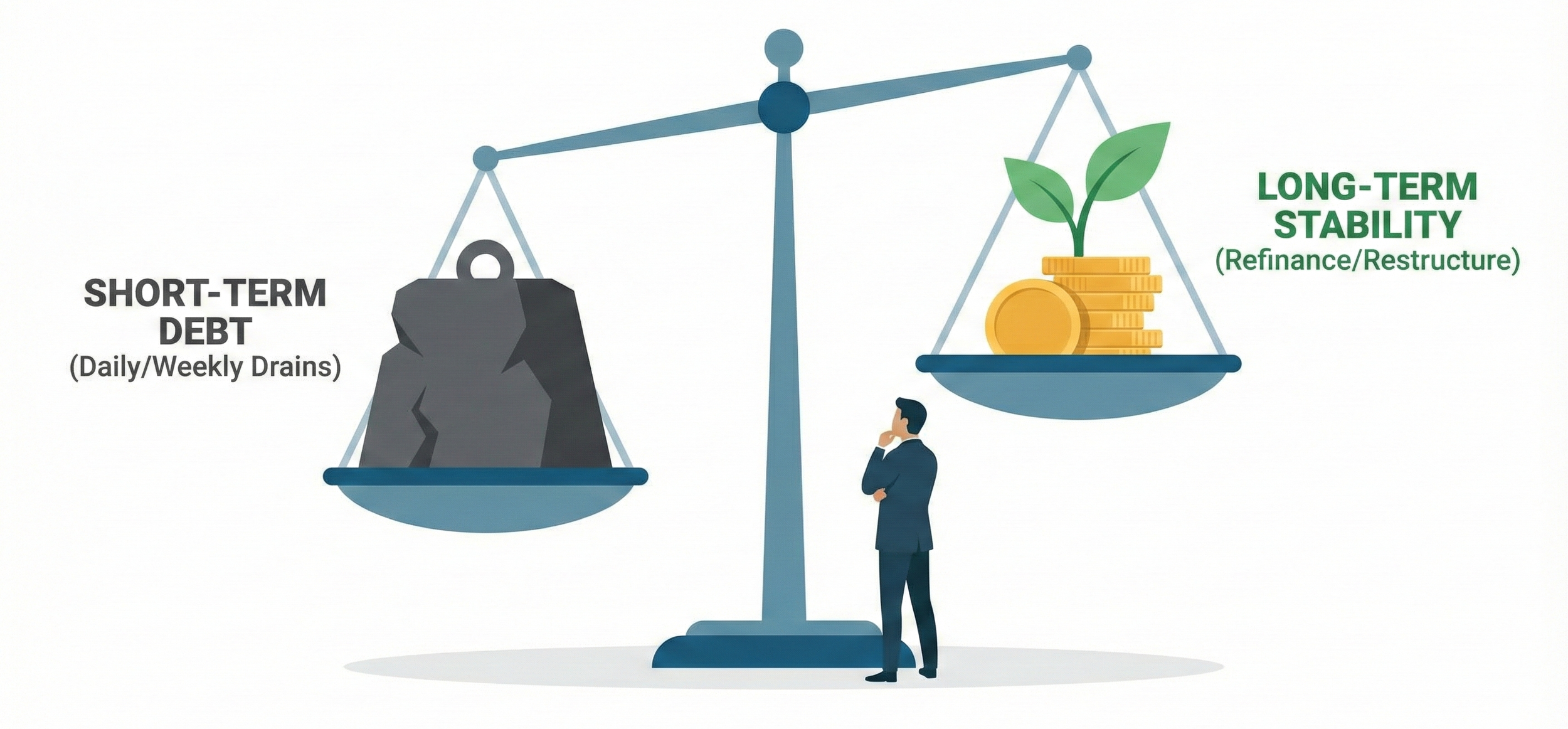Identifying Inefficiencies, Are Your Operations Bleeding Cash?
Running a small business is a challenging yet rewarding endeavor.
You pour your heart, soul, and significant financial resources into building something you believe in.
You navigate the complexities of the market, strive to provide exceptional products or services, and work tirelessly to cultivate a loyal customer base.
However, even with the best intentions and a dedicated team, subtle yet significant inefficiencies can creep into your operations, slowly but surely draining your profits and hindering your growth potential.
These inefficiencies, much like a hidden leak, can silently bleed your business dry, leaving you wondering why your bottom line isn't reflecting the hard work you're putting in.
This article is designed specifically for you, the small business owner, to shed light on the often-overlooked areas where inefficiencies can thrive.
We will explore ten key aspects of your business operations, providing you with practical insights and actionable steps to identify and address these hidden drains on your cash flow.
By taking a proactive approach to uncovering and eliminating these inefficiencies, you can plug those leaks, strengthen your financial foundation, and pave the way for sustainable success.
Understanding the True Cost of Inefficiency
Before diving into specific areas, it's crucial to grasp the real impact of operational inefficiencies.
It's not just about wasted time or resources; it's about a direct reduction in your profitability and your ability to reinvest in your business.
Consider the cumulative effect of seemingly small issues: a few minutes wasted each day by multiple employees on redundant tasks, slightly higher material costs due to poor negotiation, or a delay in your invoicing process that pushes back your cash inflow.
Individually, these might appear insignificant, but collectively, they can represent a substantial amount of lost revenue and missed opportunities over time.
Furthermore, inefficiencies can negatively impact employee morale.
When processes are clunky, tools are outdated, or roles are unclear, it can lead to frustration, decreased productivity, and even higher employee turnover.
Replacing and retraining staff is a significant expense in itself, adding another layer to the cost of unchecked inefficiencies.
By streamlining your operations and empowering your team with efficient tools and processes, you can create a more positive and productive work environment, ultimately benefiting your bottom line.
Analyzing Your Workflow Processes
One of the most fertile grounds for operational inefficiencies lies within your day-to-day workflows.
These are the sequences of tasks and activities required to deliver your products or services. Inefficiencies here can manifest as bottlenecks, unnecessary steps, duplicated efforts, or delays in the overall process.
To identify these issues, start by mapping out your key workflows.
For example, if you run an e-commerce business, map out the process from when a customer places an order to when the product is shipped and the payment is received.
If you offer a service, map out the steps involved from the initial client consultation to the final delivery of the service and payment.
Visually representing these processes can help you identify areas where steps seem redundant, handoffs are clunky, or delays commonly occur.
Once you have your workflows mapped, analyze each step critically.
Ask questions like:
Is this step truly necessary?
Can it be simplified or automated?
Is there any duplication of effort?
Are there any bottlenecks that consistently cause delays?
Talk to your employees who are directly involved in these processes.
They often have valuable insights into where things could be improved.
Tools like process mapping software or even simple flowcharts can be incredibly helpful in visualizing and analyzing your workflows.
By optimizing these fundamental processes, you can significantly reduce wasted time and resources.
Evaluating Your Technology and Tools
In today's business environment, technology plays a crucial role in efficiency.
However, outdated, poorly integrated, or underutilized technology can become a major source of inefficiency.
Are you using software that doesn't quite meet your needs, forcing your team to find manual workarounds?
Are your different systems operating in silos, requiring manual data entry across multiple platforms?
Are you paying for software subscriptions that you barely use?
Take a thorough inventory of all the technology and tools your business relies on.
This includes hardware, software, and any online services.
Evaluate whether these tools are truly enhancing your productivity or hindering it.
Consider factors like ease of use, integration capabilities, reliability, and cost-effectiveness.
Don't be afraid to explore new technologies that could automate repetitive tasks, improve communication, streamline data management, or provide better insights into your business performance.
Cloud-based solutions, for example, can often offer greater flexibility and scalability compared to traditional on-premise systems.
However, it's crucial to do your research and choose solutions that align with your specific business needs and budget.
Investing in the right technology can lead to significant long-term efficiency gains, but investing in the wrong technology can be an expensive mistake.
Optimizing Your Inventory Management
For businesses that deal with physical products, inefficient inventory management can be a significant drain on cash flow.
Holding too much inventory ties up capital, increases storage costs, and raises the risk of spoilage or obsolescence.
Conversely, holding too little inventory can lead to stockouts, lost sales, and dissatisfied customers.
Analyze your current inventory levels and compare them to your sales data.
Are you consistently overstocking certain items while frequently running out of others?
Implement a system for tracking inventory levels in real-time and forecasting demand.
Consider using inventory management software that can automate many of these tasks and provide valuable insights into your inventory turnover rate, carrying costs, and optimal order quantities.
Explore different inventory management techniques like Just-In-Time (JIT) inventory, where you receive goods only when you need them, or Economic Order Quantity (EOQ) models, which help you determine the most cost-effective order size.
egularly review your supplier relationships and explore opportunities to negotiate better pricing or payment terms.
Efficient inventory management not only frees up valuable capital but also ensures that you have the right products available to meet customer demand without incurring unnecessary costs.
Streamlining Your Communication Channels
Poor communication, both internal and external, can lead to misunderstandings, delays, errors, and wasted time.
Are your employees struggling to find the information they need?
Are emails getting lost in overflowing inboxes?
Are customer inquiries going unanswered or taking too long to resolve?
Evaluate your current communication channels and identify areas for improvement.
Consider implementing internal communication tools that facilitate seamless information sharing and collaboration.
This could include project management software, team messaging platforms, or internal knowledge bases.
Establish clear communication protocols and expectations for responding to emails and other inquiries.
For external communication, ensure that your website and other customer-facing platforms provide clear and easily accessible information.
Implement efficient systems for handling customer inquiries, whether through email, phone, or social media.
Consider using a CRM (Customer Relationship Management) system to centralize customer interactions and ensure that no communication falls through the cracks.
Streamlining your communication channels can significantly improve efficiency, reduce errors, and enhance both employee and customer satisfaction.
Managing Your Human Resources Effectively
Your employees are your most valuable asset, but inefficient human resource management can lead to significant costs.
This includes issues related to hiring, training, scheduling, performance management, and employee turnover.
Review your hiring process to ensure that you are attracting and selecting the right talent for each role.
Inefficient hiring can lead to costly mistakes down the line. Invest in proper onboarding and training programs to ensure that new employees are quickly up to speed and productive.
Optimize your employee scheduling to match staffing levels with workload demands.
Overstaffing leads to unnecessary labor costs, while understaffing can lead to burnout and decreased productivity.
Implement performance management systems that provide regular feedback and identify areas for improvement.
Recognize and reward high-performing employees to boost morale and retention.
High employee turnover is a significant cost, encompassing recruitment, hiring, and retraining expenses.
By creating a positive and efficient work environment, you can reduce turnover and maximize the productivity of your team.
Analyzing Your Marketing and Sales Efforts
Are your marketing campaigns generating the desired results?
Are you effectively converting leads into paying customers? Inefficient marketing and sales efforts can waste significant resources without delivering a sufficient return on investment.
Track the performance of your marketing campaigns closely.
Which channels are driving the most leads and conversions?
Which campaigns are underperforming? Analyze your customer acquisition cost and identify ways to optimize your marketing spend.
Ensure that your marketing messages are clear, targeted, and aligned with your ideal customer profile.
Review your sales process from lead generation to closing the deal.
Are there any bottlenecks or inefficiencies in your sales funnel?
Are your sales team equipped with the tools and training they need to succeed?
Consider using a CRM system to manage your leads, track sales activities, and forecast revenue.
By optimizing your marketing and sales efforts, you can attract more qualified leads, improve your conversion rates, and maximize your return on investment.
Scrutinizing Your Overhead Expenses
Overhead expenses, such as rent, utilities, insurance, and administrative costs, can often be overlooked as areas for potential savings.
However, even small reductions in these recurring costs can add up significantly over time.
Conduct a thorough review of all your overhead expenses.
Are you paying competitive rates for your rent, utilities, and insurance?
Can you negotiate better terms with your suppliers?
Are there any subscriptions or services that you are no longer using?
Explore opportunities to reduce energy consumption, such as switching to energy-efficient lighting or optimizing your heating and cooling systems.
Consider consolidating office space if possible or exploring remote work options to reduce rent and utility costs.
Regularly review your vendor contracts and look for opportunities to negotiate better pricing or switch to more cost-effective alternatives.
While individual overhead costs may seem small, collectively, they can represent a significant portion of your overall expenses.
By scrutinizing and optimizing these costs, you can directly improve your profitability.
Reviewing Your Financial Management Practices
Inefficient financial management can lead to missed opportunities, unnecessary fees, and even serious cash flow problems.
This includes issues related to invoicing, accounts receivable, accounts payable, and budgeting.
Ensure that your invoicing process is timely and accurate.
Delays in sending invoices can lead to delays in receiving payments.
Implement clear payment terms and follow up promptly on overdue invoices.
Consider offering online payment options to make it easier for customers to pay you.
Manage your accounts payable effectively.
Pay your bills on time to avoid late fees, but also take advantage of any early payment discounts offered by your suppliers.
Develop a realistic budget and track your actual spending against your budget regularly.
Identify any areas where you are consistently overspending and take corrective action.
Regularly review your financial statements and key performance indicators to gain insights into your business's financial health and identify potential areas for improvement.
Efficient financial management is crucial for maintaining a healthy cash flow and making informed business decisions.
Embracing a Culture of Continuous Improvement
Identifying and addressing inefficiencies is not a one-time task; it's an ongoing process that requires a commitment to continuous improvement.
Encourage your employees to identify and suggest areas where processes can be improved.
Foster a culture where efficiency is valued and where everyone is empowered to contribute to making the business more streamlined and profitable.
Regularly review your key performance indicators (KPIs) related to efficiency, such as production time, error rates, customer response times, and inventory turnover.
Track your progress in implementing changes and measure the impact on your bottom line.
Be willing to experiment with new approaches and adapt as needed.
The business landscape is constantly evolving, and what was efficient yesterday may not be efficient today.
By embracing a mindset of continuous improvement, you can ensure that your operations remain lean, agile, and profitable in the long run.
By systematically examining these ten key areas of your business operations, you can uncover the hidden inefficiencies that may be bleeding your cash flow.
Implementing the strategies and taking the actionable steps outlined in this article will not only help you plug those leaks but also strengthen your overall business performance, enhance your profitability, and pave the way for sustainable growth and success.
Remember that even small improvements in multiple areas can have a significant cumulative impact on your bottom line. Start today, be persistent, and reap the rewards of a more efficient and profitable business.
WHAT IS THE BEST AND SAFEST WAY FOR YOUR BUSINESS TO DEAL WITH HIGH BUSINESS DEBT PAYMENTS?
It is NOT by stopping ACH payments.
It is NOT by taking on another business loan.
It is NOT ALWAYS a Refinancing
It is NOT by entering into a debt settlement program.
Find out the BEST strategies to get your Business back to where it was



















